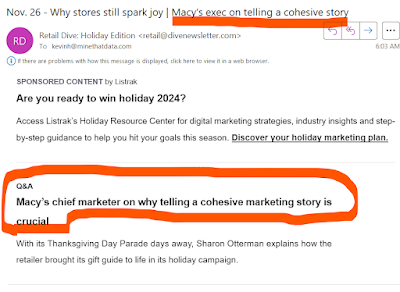Let me tell you a story.
This one is from Lands' End, nearly thirty (30) years ago. I'm 29 years ago and dumb as a box of hammers. Oh, I have the data on my side. The data tells us that if I send 80 pages of Men's Tailored merchandise in a standalone catalog I am heavily cannibalizing the same product (and other products) in my core monthly catalog. If the catalog is forecast to generate $5,000,000 in sales and $750,000 in profit, the reality is that 70% of the $5,000,000 would happen anyway if the catalog was not mailed - it would happen in the core monthly catalog instead. So the $5,000,000 catalog with $750,000 in profit is, in reality, a $1,500,000 catalog that is losing $250,000 of profit.
As a young analytics manager, I hold the moral high ground here (at least that's what I believe). I've tested the results. I have #facts on my side. Any other form of analysis is inferior to the repeated A/B test results which consistently tell the same story, over and over and over again. I'm brilliant, everybody else is an idiot. I'm ready to die on this hill.
One problem. The company moved on. The folks who manage these individual catalogs "won". The CEO who supported integrating the business units was fired, replaced by a person loyal to the individual catalogs. No amount of shoving facts in people's faces is going to matter. None. The issue has been decided.
In the meantime, my Marketing Director hires a Manager from Fingerhut. A very talented woman. Kind. At the end of a meeting we're idly chatting about various topics and I decided to go into a rage about how right I am regarding circulation strategy. I can tell this new hire feels uncomfortable. Hint - if you are a male in a meeting and you are causing a woman to feel uncomfortable, you're doing something wrong.
The new marketing manager looks at me and says "I realize you might be right, but the company moved on, and I simply don't understand why you keep trying to fight a battle you already lost. Worse, the way you argue reflects poorly on you. Why would anybody listen to somebody as angry as you are?"
The fact that I'm sharing this with you twenty-nine years later tells you how much of an impact this woman had on my career. She was right, I was wrong.
If you are an analyst you likely feel as if you are "right". For good reason! You have facts on your side, everybody else has gut feel. You have solid methodology on your side, everybody else leverages faulty methodologies. If somebody else comes to you with "a way" of analyzing something, you're probably quick to point out the flaws in that style of analysis. After all, you are "right" and they are "wrong".
This is where you have to be really careful.
Putting somebody on blast mode because they don't analyze things the way you'd analyze them might feel good, but it doesn't do anything for your credibility. If anything, it just causes the person receiving your feedback to think you are a jerk. You want the opposite to happen - you want the recipient of your message to think you are a genius.
Just because you are "right" doesn't mean you are "Right".
There's a reason I was required to attend Dale Carnegie training around this time in my career. I had to learn how to become a salesperson. I had to convince somebody who wasn't on my side to execute my tactics.
It is difficult to be an analyst, to convince people to do things that work against their instincts. It's hard to be smarter at something than somebody else, only to have "somebody else" question you or recommend tepid ideas that won't work. It's also hard to understand your blind spots. All of us have weaknesses that we simply cannot see, but are obvious to anybody working with us. Learning what we're good at ... that is an important skill ... and then not straying outside of what we're good at ... that's valuable to the companies we work for.








